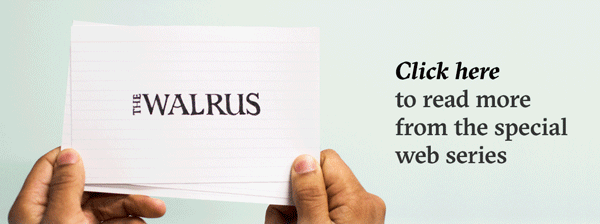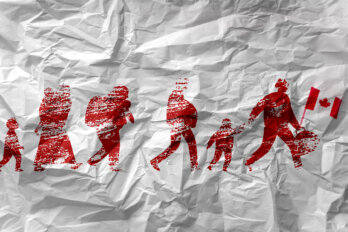Picture this: everyone in your life is obsessed with ice cream, and you just don’t understand the hype. You’ve tasted it, and maybe you’ve even enjoyed it from time to time, but you don’t actively crave it like the people around you seem to—nor do you centre your life around it like they do. “Can’t wait to get some ice cream!” they effervesce in tweets and Facebook posts, and you wonder why. Dates with potential romantic partners, and even get-togethers with friends, often seem organized around the acquisition or discussion of ice cream, pushing you further into an isolation that feels like your own doing.
Walking down the street, or roaming the internet, you’re bombarded with ads—“Sweet, cold bliss in a sumptuous cone!” “Chocolate, vanilla, strawberry: What’s your pleasure?”—and, at first, this annoys you, but as time goes on, it begins to make you feel downright broken. Expressing this disconnect to friends is usually met with the accusation that you “just haven’t had any good ice cream yet,” but you know that isn’t true; you simply don’t like the stuff.
Imagine, too, that no one ever told you it was possible to dislike ice cream or even to feel neutral about it. Imagine wondering if other people like you exist in the world—how much it would change your life if someone told you, “Some people just don’t like ice cream, and that’s okay.”
This is a metaphor—albeit a comparatively mild and whimsical one—for the predicament faced by the more than 1 percent of the population who are asexual (“ace” for short), meaning they don’t experience sexual attraction. They are the friends and family members who don’t express any desire to pursue sexual intimacy, who don’t often or ever seem interested in conventional dating, and who get pushed to the sidelines in any conversation about sexual health. Much like same-sex attraction decades ago, this nonattraction was initially (and is sometimes still) conflated with a sexual-desire disorder, worthy of pathologization and medical treatment with pharmaceuticals or therapy. But scientists have confirmed asexuality isn’t a medical issue; it is a sexual orientation on the same plane as heterosexuality, homosexuality, and bisexuality.
Though asexual advocacy has made strides in the past couple of decades, that hasn’t translated to adequate research or mainstream awareness. There had been little to no scholarly research on the topic until, in 2004, Anthony Bogaert, a professor of health sciences and psychology at Brock University in St. Catharines, Ontario, published a seminal study about the so-called fourth sexual orientation, which inspired new lines of inquiry after decades of silence. Popular culture has also seen a rise in acknowledgement of the orientation: there’s an explicitly asexual character, Todd Chavez, on Netflix’s BoJack Horseman, and it’s been argued that Sherlock Holmes, Sheldon Cooper of The Big Bang Theory, and even Jughead of the Archie comics might be asexual.
Despite this progress, public-health and educational circles seem to be lagging behind. Asexuality is not included in most sex-ed curricula across Canada; it’s not mentioned in Ontario’s 2015 curriculum nor in the previous one from 1998, which schools have reverted to this year. (It is, however, mentioned in the suggested lesson plans on Alberta-based teachingsexualhealth.ca and in an addendum to the Northwest Territories curriculum.) The 2015 Ontario curriculum questioned harmful portrayals of gay characters in media, defined and decried homophobia, and suggested schools start gay-straight alliances to help LGBTQ students feel less alone—but no such support was given specifically to asexual students. A 2012 poll of over 400 asexual people online found that most of them had first heard the word asexual from friends and peers or from the internet. Only 1.6 percent of them had heard the term in school.
Though “abstinence-only” sex ed has long been criticized, teachers and health professionals should acknowledge not just teenagers’ desire for sex but also their potential lack of desire. Including nonnormative sexual orientations in school is an important way to make LGBTQ youth feel welcome and validated: a widely cited 1979 study of “homosexual identity formation” even posited that the “interaction between individuals and their environment,” in the form of encountering other queer people and information about queerness, is crucial to understanding one’s own LGBTQ identity. And yet asexual kids aren’t afforded the same right to discover their identity and see it validated in school. As our conversations about comprehensive sex ed have become more nuanced and inclusive, they are still missing a critical element: we need to remember that not everyone is interested in sex.
Brian Langevin, the executive director of non-profit organization Asexual Outreach, didn’t discover the term “asexuality” until a friend mentioned it to them at age sixteen. It immediately felt like a good explanation for their lifelong lack of sexual attraction. (Langevin identifies as nonbinary and uses they/them pronouns.) Many asexuals don’t put a name to their identity until at least their late teens, Langevin says—long after most of their peers have figured out who they’re attracted to and how. “If someone is gay, as an example, it’s pretty easy to say, ‘Okay, well, I experience the same type of attraction that everyone else does, it’s just pointed at a different gender,’” Langevin says. “For asexual people…they might not even know that sexual attraction exists, and to them, the whole world could seem very confusing.”
Langevin’s decision to move from Kamloops, British Columbia, to Toronto and found Asexual Outreach was largely spurred by the isolation and confusion they experienced as a teenager. “One of my primary driving factors in wanting to spread awareness and outreach is preventing other people from going through the same thing I did,” they told me. “Growing up, I didn’t know that asexuality existed….I felt like there was something wrong with me.”
Their organization now works to support asexual advocacy and distribute resources about asexuality throughout Canada and the United States, in the hopes of shedding some light on an issue that leaves many young people in the dark. Their latest project is acesandaros.org, a new platform for connecting asexual and aromantic (i.e., experiencing little or no romantic attraction) people with community groups that offer “social events and discussions” and with advocacy efforts that work to disseminate information to the general population.
These programs are important and, in some cases, may even be a matter of life or death. A 2013 study in BC found that asexual individuals are more likely to suffer from depression, anxiety, and suicidal thoughts, owing perhaps in part to feeling “isolated, distressed or confused” by the relative invisibility of their orientation. As with many nonnormative sexual identities, asexuality may not be accepted at face value by those who don’t understand it. “If someone is coming out to you as asexual, it probably means they thought long and hard about it. And yet people will disbelieve them. It’s quite common,” Langevin said. A 2018 paper out of New York’s John Jay College of Criminal Justice identifies several types of discrimination experienced by asexual people, including invalidation, pathologization, dehumanization, rejection, infantilization, tokenization, and sexual pressure. Needless to say, being told over and over again that your identity isn’t real or worth respecting can do lasting damage to your emotional state.
Social isolation can contribute to this damage. When you’re a member of “the invisible orientation,” as asexual author Julie Sondra Decker called it in her 2014 book of the same name, it’s hard to sleuth out other members of that tiny 1 percent. (That number, by the way, might not even be accurate; Langevin thinks more people would align themselves with asexuality if they knew it existed.) Many asexuals turn to internet communities to find kinship with people who “get it.”
Mikayla Micomonaco, an Ottawa-based aerospace-engineering student who also uses they/them pronouns, discovered the term asexual through a friend, like Langevin did. In high school, Micomonaco’s disinterest in sex and romance so confounded their peers that a boy in their class told them they must be the only person of their generation born without the capacity for sexual attraction. Upon hearing Micomonaco describe how they felt later on, a friend from their university residence suggested they look up the word asexual. When Micomonaco took to Google, their search led them to the website of the Asexual Visibility and Education Network, one of the best-known online information hubs for the ace community. “I wouldn’t know about [asexuality’s] existence without the internet,” they said. “It was a relief to realize that I wasn’t the only person in the world like me.”
It’s understandable why Micomonaco might feel ostracized by society—they’re also aromantic (24.7 percent of the ace community identifies as aromantic, according to the 2015 Asexual Census Summary Report). “People are very concerned that I’m going to die alone or that I’m somehow broken, defective, or less human because I don’t experience romantic attraction,” they told me. For those asexuals who do form romantic relationships, nonmonogamy is one way of bridging the sex gap between aces and their non-ace partners: some statistics indicate asexual people are more likely to be polyamorous (i.e., open to dating more than one person at once, with participants’ full knowledge and consent) than the general population.
Asexuality and celibacy, it should be noted, are a Venn diagram, not a perfect overlapping circle. About a third of asexual people are “sex repulsed”—which is exactly what it sounds like—while the rest feel anywhere from indifferent to favourable on the subject. Sex without sexual attraction might seem counterintuitive, but there are other reasons one can enjoy sex: pleasure, orgasm, intimacy, fun, and stress relief, for example. Even nonasexual people can attest to this, if they’ve ever been in a relationship where white-hot attraction has faded over time but sex with one’s partner remains fun and fulfilling nonetheless. Solo sex isn’t necessarily off the table for asexuals either: a 2016 study conducted in BC found that upwards of 70 percent of asexual people masturbate at least monthly, versus about 90 percent of their allosexual (nonasexual) peers.
Knowing asexual people, whether from a distance or in a more intimate capacity, invites the allosexuals among us to examine our culture’s tendency toward hypersexualization. Sexual objectification and fixation run rampant in our media and even in the ways we relate to one another at work or in social situations. But asexual people are slowly starting to change that narrative. Taryn Bates, a Seattle-based asexual blogger, has written about how closeness can be fostered between partners with activities like touching each other nonsexually, communicating more effectively, and expressing appreciation liberally.
True emotional intimacy is created, according to psychology, by honesty, empathy, and listening. When we oversimplify relationships by insisting, on a sociocultural level, that sex is the ultimate key to and only sign of a profound connection, we deprive ourselves of the more holistic affinities available to us if we look for more. School programs in Canada teach students about the dangers and logistics of sex itself, for the most part. But truly inclusive sex ed would also cover pleasure, intimacy, and communication—and the reality that sex, like ice cream, simply isn’t for everyone.





